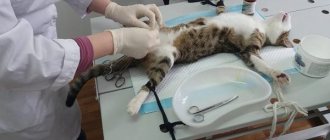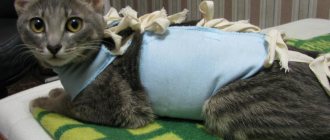Veterinarians advise not to postpone sterilization of a cat indefinitely, since with each passing year the likelihood of postoperative risks increases. The intervention is recommended for all animals not involved in breeding, and is recognized as the most effective prevention of oncology.
Why do you need to sterilize your cat?
After puberty, cats begin to look for a mate. They leave scent marks, scream at night and constantly try to escape from the house. This is a difficult period for every owner. Despite the difficulties that arise, not everyone is in a hurry to resort to surgical intervention, fearing possible risks. Most often, owners resort to an alternative solution - hormonal drugs. They really suppress sexual desire, but with constant use they carry much more risks: the growth of tumors, the development of pathologies of the reproductive system (cyst, pyometra) and urinary systems.
Unlike hormonal drugs, sterilization permanently eliminates sexual desire and reproductive function. It has a beneficial effect on the pet’s condition, protects it from cancer and prolongs its life.
The life of a neutered Scottish cat
Neutered Scottish cats tend to exercise less, so care must be taken to ensure they do not become obese. To do this, you should feed them a special menu for castrati, and also encourage them to engage in physical activity. This is easy to do by buying interesting toys and starting a gaming complex.
Otherwise, it will be a pet without the problems of sexual hunting, kinder and less aggressive.
It is also important that sterilization prolongs life, eliminating the need to deplete the body with constant estrus and childbirth, and accumulate hormones, which sooner or later, as we have already written, lead to an explosion in the form of inflammation and cancer.
Let your cat be happy and healthy!
Difference between castration and sterilization
Sterilization (oophorectomy) is tubal ligation with or without removal of the ovaries. Most often, veterinarians perform castration (ovariohysterectomy), which involves removing not only the ovaries, but also the uterus. This method is more effective, as it eliminates the development of tumors and inflammatory diseases in the uterus.
Many people confuse these concepts, separating them not by the specifics of the procedure, but by gender. In everyday life, it is believed that females are sterilized and males are castrated. For convenience, instead of “castration” we will use the more familiar term “sterilization”.
Extirpation of the uterus of a pregnant cat
Sterilization of a pregnant cat is permissible only if there are serious indications. The procedure is called hysterectomy. It is carried out in a standard way - the ovaries and uterus are removed.
If the animal is healthy, veterinarians do not recommend surgery. The longer the period, the higher the risk of complications and the postoperative recovery will be long. Pregnancy for up to 1 month, as a rule, does not cause complications. If the period is more than 1 month, severe blood loss occurs during the operation. The animal takes a long time to recover.
Brief description of the operation
To minimize possible complications, preparatory measures are recommended. They include not only actions immediately before surgery, but also ongoing disease prevention. In particular, this refers to annual vaccination.
Preparing the animal
Anesthesia weakens the immune system, increasing the risk of infection by harmful microorganisms and parasites. For safety, it is recommended to vaccinate your pet at least a month before the procedure. Treatment for helminths is carried out within 1.5-2 weeks. In the absence of timely vaccination, the cat is given a serum injection that stimulates a stable immune response for 2 weeks.
A few days before surgery, a urine and blood test is taken from the tailed patient. To determine the safe dosage of a narcotic substance, the functioning of the heart and respiratory organs is checked using ultrasound and x-rays.
It is recommended to give up feeding 12 hours before, and water 3 hours before. This eliminates the occurrence of vomiting, which provokes the development of aspiration pneumonia.
Choosing a clinic and veterinarian
Pets that don't go outside are afraid to leave their familiar territory. To minimize stress, it is better to choose a clinic closer to home. Walking distance will eliminate travel by transport, reducing the time you spend outside your usual conditions.
For especially timid pets, calling a veterinarian to your home is a good idea. This eliminates the stress caused by a change of environment and the risk of infection from other visitors. The disadvantage of home surgery is the low sterility and lack of equipment necessary to eliminate possible complications. Most clinics provide both types of services, so the choice is up to the owner.
It is ideal if you vaccinate your animal and take it for routine examinations to the same clinic and to the same doctor. A regular veterinarian is familiar with the characteristics of the body.
Progress of the procedure
After anesthesia is administered to the tailed patient, the hair is removed at the site of the future incision or puncture. The procedure itself is carried out in two ways:
- surgical, involving classical excision with a scalpel;
- laparoscopic, based on the creation of small punctures using endoscopic equipment.
In both cases, after making an incision, the surgeon removes the reproductive organs and applies stitches. They are removable and non-removable. The first ones are removed 7-10 days after the procedure, and the second ones resolve on their own.
Preparing for surgery
Before sterilization, the cat must be:
- absolutely healthy;
- vaccinated against infections - vaccinations should be done a month before the expected sterilization.
After anesthesia, cats often feel sick and vomit, so you should not feed the animal 10 hours before surgery, you are only allowed to drink water.
Important! It is better to do the operation during the pause between estrus.
It’s more difficult with older animals: an external examination cannot always reveal hidden ailments, so additional examination will not hurt:
- blood and urine tests;
- heart examination;
- Ultrasound of internal organs (will reveal tumors and cysts that can be removed during sterilization).
Pros and cons of sterilization at different ages
When sterilizing, age plays a primary role. Veterinarians' opinions on the ideal age vary, but the fact that a young body is at lower risk remains the same.
Early (before first heat)
Foreign veterinarians believe that it is better to sterilize a cat when it has not yet reached puberty. This approach guarantees rapid tissue regeneration, reducing postoperative risks. Surgery is performed at 3-6 months.
Opponents of this approach cite possible developmental delays, changes in behavioral characteristics, and the development of pathologies of the eyes, kidneys and endocrine system. There is no consensus here, since supporters of early sterilization have a completely opposite opinion. They are confident that the operated animal grows up healthier.
During puberty
Most veterinarians recommend operating on your pet closer to her first heat, that is, at 7-8 months. Exceptions include kittens of different sexes from the same litter growing up together. They reach puberty earlier, so the date of surgery can be delayed by 4-6 months. Before making a decision, the veterinarian weighs the tailed patient. Its weight should be at least 2.5-3 kg. Otherwise, the operation will be delayed.
In old age
People who have picked up adult animals on the street are constantly wondering at what age a cat can be sterilized. In their case, the chance for early intervention has already been missed, so the issue is resolved individually.
Veterinarians believe that surgery is possible up to 10 years of age. After this age, the pet is considered old, and the likelihood of complications increases to a critical level. Surgery is performed only for special indications that threaten the life of the tailed patient.
Features of sexual development in different breeds
The timing of puberty varies from breed to breed. If your pet begins to show signs of heat too early, check with your veterinarian at what age cats of this breed are sterilized. Representatives of the Siamese-Oriental group mature from 4 months, and large long-haired breeds (Maine Coons, Persians, Siberians) - up to 1 year.
How is a cat sterilized?
In a good clinic, the cat will be given premedication - preliminary medical preparation of the body for anesthesia and surgery. After this, anesthesia is administered. Under anesthesia, a cat's eyes are open, so they will need periodic wetting with a special preparation to prevent drying out.
Article continues after advertisement
Under anesthesia, the veterinarian will shave the cat's belly hair and make a skin incision below the belly button for traditional surgery. In the case of laparoscopy, small incisions are made. After this, the genitals (uterus and ovaries) are removed. In a traditional operation, the surgeon does this by seeing the organs with his own eyes directly in the section. During laparoscopy, he sees the organs on the screen, and at this time they are in the abdominal cavity.
At the end of the operation, stitches are applied. There are sutures that need to be removed after 10 days, and there are self-absorbing ones. In the case of a traditional operation, after suturing the cat, a blanket is put on the cat; in the case of laparoscopy, there is no such need.
What age is ideal - veterinarians' opinions
Doctors' opinions on what age is best to sterilize cats agree on one thing. Each subsequent year after the onset of estrus reduces the effectiveness of the procedure and increases the likelihood of complications.
The probability of developing oncology in animals operated on before their first heat is only 0.5%. At the time of surgery, the pet must be at least 7-8 months old. The exception is breeds with early maturity or kittens from the same litter.
Consequences
The consequences of a cat sterilization operation depend on how many months the procedure was performed. If the manipulation was performed before the onset of puberty, when the internal organs of the animal are not yet fully formed, the risk of further inflammatory diseases of the urinary tract and the formation of stones is increased.
It has been noted that Scottish Fold cats require a special diet. If fed improperly, animals quickly gain weight. Obesity in Scottish cats often causes problems with the cardiovascular and respiratory systems. These pathologies can negatively affect the life expectancy of the animal.
All information posted on the site is provided in accordance with the User Agreement and is not a direct instruction to action. We strongly recommend that before using any product, you must obtain a face-to-face consultation at an accredited veterinary clinic.
Estrus, pregnancy and childbirth
Not all owners understand the relationship between the reproductive and reproductive systems. Because of this, it is completely unclear when to spay a cat: before, during or after heat. Even more difficulties arise with the need for childbirth. Many owners mistakenly believe that deprivation of reproductive function is safe only after bearing at least one litter.
Surgery during pregnancy
Surgery is permissible if the pregnancy is no more than 1 month. Otherwise, there is a possibility of increased blood loss and a prolonged postoperative period. Intervention is also permissible in case of abnormal fetal development, poor health or old age, which prevents the safe bearing of kittens. In all other cases, the operation is postponed until complete postpartum recovery.
Surgery after childbirth
After giving birth, a young mother needs 2-3 months to fully recover. During this time, the uterus returns to its original size, and blood circulation in the pelvis is normalized.
Emergency intervention immediately after the birth of kittens is practiced when:
- detection of tumors in the reproductive organs;
- the presence and high probability of postpartum hemorrhage;
- uterine rupture;
- damage or abnormalities of the placenta.
In these situations, the risk of possible complications is higher than the risks associated with sterilization. The procedure is considered justified.
Is it necessary for a cat to give birth at least once before sterilization?
The most popular question arising from the baseless myth about the “joy of motherhood.” From a psychological point of view, animals are not subject to emotions and act instinctively. The absence or presence of pregnancy is taken for granted by them, and therefore does not have a fundamental impact on their lives.
An obvious logic appears when considering the issue from a biological point of view. Before pregnancy, female sex hormones (estrogens), responsible for sexual desire, are produced by the ovaries. If they are removed in a timely manner, the animal loses not only the ability to conceive, but also interest in the opposite sex. Otherwise, other internal secretion organs are involved in the production of estrogen. As a result, the operated pet will not be able to become pregnant again, but will continue its loud rituals of calling cats. If you do not want to endure such concerts for the rest of your furry pet’s life, do not allow mating until sterilization.
In addition to the high risk of retaining some sex hormones, pregnancy reduces the effect of the procedure. The probability of developing cancer after the first birth is 8%, and after the second it increases by more than 3 times.
Is it possible to operate on a cat during heat?
During estrus, hormonal changes occur. Any intervention is fraught with multiple complications, including the development of oncology. Due to the dilation of blood vessels, there is a high probability of heavy blood loss. Animals recover from anesthesia worse and have a more difficult time experiencing the postoperative period.
It is safer to carry out surgery 2 weeks before or after estrus, when the pet’s condition returns to normal. Exceptions include prolonged heats with a short interval between them. They impair quality of life and lead to exhaustion. In this case, the animal is sterilized for medicinal purposes.
Caring for your cat after surgery
The main thing in the postoperative period is to provide the animal with rest. Therefore, the pet should be put to sleep in a warm place without drafts, covered with a blanket. You should not place it on a sofa or other elevated surface, as the cat will lose coordination due to anesthesia after sterilization and may fall. It is worth refraining from feeding during the first day; you can give water after 4-6 hours.
You should seek help if your pet exhibits an inadequate reaction:
- increase or decrease in temperature;
- frequent vomiting;
- fainting;
- inflammation;
- bleeding and suppuration of the suture;
- belly that is hard to the touch.
To prevent the cat from injuring the seam, she is given a special blanket. However, daily care and treatment is required.
Indications and contraindications
There are always exceptions to general rules. In some cases, surgical intervention is permissible even if there are contraindications.
When should an animal not be sterilized?
It is prohibited to sterilize an animal that has not been vaccinated or previously treated against parasites. Other possible contraindications include:
- old age (more than 10 years);
- pathologies of the cardiovascular system and respiratory organs;
- acute viral infections and chronic lesions of the genitourinary system;
- estrus, pregnancy and the postpartum period, including lactation.
Neglecting the listed contraindications is permissible in case of a serious threat to life. If other methods to prevent dangerous complications do not help, the pet is sterilized.
When is surgery necessary?
Emergency surgery is rarely performed. It is prescribed when it is detected:
- abnormalities associated with pregnancy;
- malignant neoplasms in the reproductive organs and mammary glands;
- false pregnancy.
It happens that with incomplete removal of the ovaries, repeated estrus appears. To eliminate the consequences of unsuccessful sterilization, the animal is operated on again.
Alternative Sterilization Methods
Chemical sterilization
There is another method of solving the problem - chemical. The animal's ovaries are exposed to a certain radiation, after the procedure they cease to perform their functions. The cat's remaining organs remain safe and are covered with lead sheets.
Advantages of chemical sterilization:
- no scar remains on the body;
- the risk of developing infections and inflammations is reduced;
- relatively fast recovery period.
The main disadvantage of this method of sterilization is that the cost of chemical intervention is much higher than usual. An overdose of radiation threatens the death of the animal, but such an outcome is only possible in the event of a medical error.
Laparoscopy.
Laparoscopy is a type of surgical intervention in which a minimum number of incisions are made, no larger than 1 cm in size. Special tubes are equipped with special devices, a camera and a light source. Laparoscopy is considered a gentle method of organ removal. It is recommended for pets from 6 months to 15 years. Since the incisions are small, pain after surgery is minimal, it is easier to care for the sutures, and a postoperative blanket is not needed.
Find out more about laparoscopic sterilization of cats.
When is a Scottish cat neutered?
Veterinarians give clear advice at what age to castrate Scottish kittens - as soon as possible after birth, approximately 10-12 months. This is the optimal age for the operation, when the animal is considered sexually mature, hormones in the body have played a role in development, so there are no contraindications to castration of a Scottish fold cat. The main thing is that the cat is healthy and is examined by a veterinarian.
If a cat is neutered after the experience of mating with a cat, then he may retain the mating process, as well as intuitive memory and behavior.
A Scotsman can and should be castrated at any age, but preferably before the age of 5, when he does not have age-related diseases.
The cost of castration surgery varies depending on the region of the Russian Federation, as well as where it is performed. Calling a veterinarian to your home is convenient for the owner and the cat, but is complicated by special preparations for the site for surgical procedures.
Table No. 1 Approximate cost of castration of cats in different cities of the Russian Federation.
Why do they castrate?
Many people choose a Scottish fold or straight-eared kitten for the soul, because of their love for this breed of cat. Often, breeders themselves neuter pet-class kittens with slight deviations from the standard before sale. This is especially true for Scottish Folds, who are susceptible to genetic diseases due to improper mating.
Unsterilized cats, in the absence of mating, mark the space with stinking urine, during sexual behavior they loudly make terrible sounds and show aggression, which forces the owner to resort to castration surgery.
A conventional operation (orchiectomy), when the testicle in the scrotum needs to be removed, goes quickly. It only takes 15 minutes for the veterinarian to make one small incision, remove the testes, and return the pet to the owner.
Minor complications can arise when you need to castrate, and the kitten is diagnosed with cryptorchidism:
- the ovary-testis is not descended into the scrotum:
- the ovary-testis is located outside the scrotum;
- the ovary-testis is incorrectly located, under the skin in the groin or perineum.
In case of such deviations, the “cryptorchus” operation can be performed in the following ways:
The open method requires surgical intervention with an incision in the place where the ovary-testis is found:
- A more gentle intervention using a puncture, through which the doctor performs all manipulations to remove the ovary and testis.
- Scottish cats should not be fed 5 hours before the operation, because it is performed under anesthesia, and the animal may vomit.
Pet after castration
The entire postoperative period for both straight-eared and fold-eared kittens will last several days and pass without complications. The Scottish cat will need special care on the first day when he recovers from anesthesia:
- be sure to place a sanitary napkin under it; if it is weakened, it may not reach the tray;
- provide a warm place; after surgery, the cat’s internal heat exchange is disrupted;
- Do not place the cat in high places so that it does not fall;
- do not force him to eat, but place him next to a container of water.
After recovering from anesthesia, a well-rested pet will behave as usual. It is important to make sure that he does not lick the incision site. To do this, a postoperative collar is put on him. The wound is treated with an antiseptic for several days.
What vaccinations are given to kittens, cost
Small, helpless kittens receive the first antibodies that increase immunity along with the mother's cat's milk. After weaning, instead of colostrum, the baby needs additional protection of the body from viruses and bacteria. At the age of 8-10 weeks, vaccinations are required for Scottish kittens. Before the first vaccinations are carried out, the kitten is prepared and the body is prevented from worms.
Depending on the conditions of detention and lifestyle, the first vaccination for a Scot contains:
- a vaccine against herpesvirus, calicivirus, panleukopenia and rabies, even if the animal leads a permanent home lifestyle;
- They also vaccinate against viral leukemia and chlamydia if the kitten lives in a private house, in a country house and leaves the house where it has likely contact with other animals;
Vaccinations for fold-eared kittens, as well as straight-eared Scots, are performed in accordance with the following scheme:
- At 2 months, the full range of vaccinations with the exception of the rabies vaccine;
- At 3 months, revaccination is carried out with the same complex of drugs with the addition of rabies vaccine.
- Every year and beyond, as the child grows, the entire vaccination package is repeated, including the anti-rabies drug.
The cost of vaccination depends on the price of the drug and factors of the procedure in different regions of the country and consists of:
- from the cost of the most common complex of drugs: Purevax RCPCh + Rabizin + Nobivac Rabies;
- prices for issuing a veterinary passport;
- payment for the work of a veterinarian;
- payment for calling a doctor to your home.
Adults (what vaccinations are given to adults + cost)
Vaccinations for adult cats and Scottish cats have the following advantages:
- they support the immunity of animals to environmental living conditions.
- Vaccinated pets develop a persistent, throughout the year, resistance to serious diseases;
- The vaccinated animal is protected itself and the owner is guaranteed protection, for example, from rabies;
- The occurrence of some infectious processes in a mild form
- When walking in nature and interacting with other animals, the risk of your pet contracting an infection is reduced to a minimum.
Throughout life, the vaccination procedure is repeated annually, preferably in the same month of the year. They make sure that the animal is dewormed on time, is healthy, and that the cat is not pregnant or nursing cubs.
The basic composition and cost are similar to vaccination for kittens, depending on the region and other factors.











